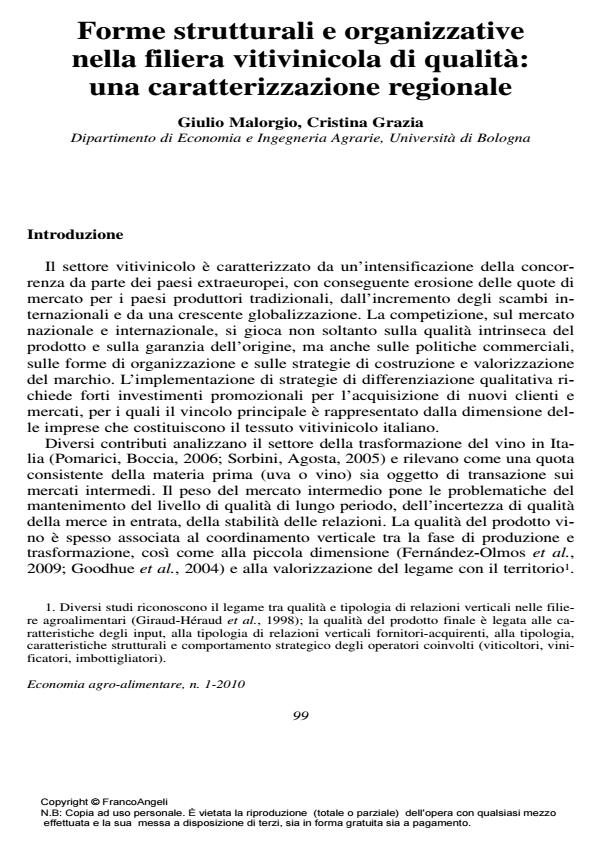Structural and organizational aspects of quality wine supply chain: a regional analysis
Journal title ECONOMIA AGRO-ALIMENTARE
Author/s Giulio Malorgio, Cristina Grazia
Publishing Year 2010 Issue 2010/1
Language Italian Pages 19 P. 99-117 File size 599 KB
DOI 10.3280/ECAG2010-001006
DOI is like a bar code for intellectual property: to have more infomation
click here
Below, you can see the article first page
If you want to buy this article in PDF format, you can do it, following the instructions to buy download credits

FrancoAngeli is member of Publishers International Linking Association, Inc (PILA), a not-for-profit association which run the CrossRef service enabling links to and from online scholarly content.
The quality of the processed product and the strategies on the final market strongly depends on the types of vertical relationship among the supply chain participants, on the types of economic agents (vine growers, wineries, bottlers), on their structural and organizational characteristics. We provide an original study of the wine processing sector by taking into account the role of the supply chain organization in determining the quality of the processed product. Indeed, the objective of this paper is to study the relationship between structural and organizational characteristics of the Italian wine processing sector and the incidence of quality wine production. Furthermore, we provide a regional description of wine processing units in terms of quality, plants’ size, type of vertical relationship and final product’s valorisation on the final market (through bottling specialization and localisation indexes). This analysis is based on the treatment and elaborations of data concerning harvest and production declarations (source: agea) and wine bottling stage (source: Infocamere - Unioncamere). Wineries are classified according to the degree of vertical integration between the vine-growing and the wine processing stage in agricultural wineries, industrial wineries and cooperatives. At national level, we show that agricultural wineries are mainly characterized by low quantity but high quality wine production, while industrial wineries are mediumbig size firms mainly oriented to table wine production. The regional analysis makes it possible to identify and describe some "structural and organizational typologies" that may characterize specific regional areas. We first point out a positive relationship between the incidence of quality wine production and the quantity of wine processed by (1) small-medium plants’ size wineries and (2) vertically integrated wineries. Moreover, we show that a strong regional orientation to quality wine production may coexist with a high level of specialization in bottling activities that facilitate the strategies for the development of brands on the final market (both of locally produced wine and of wine produced outside the region).
Keywords: Quality, vertical relationship, wine processing sector, regional analysis
Jel codes: L66, Q12
Giulio Malorgio, Cristina Grazia, Forme strutturali e organizzative nella filiera vitivinicola di qualità: una caratterizzazione regionale in "ECONOMIA AGRO-ALIMENTARE" 1/2010, pp 99-117, DOI: 10.3280/ECAG2010-001006